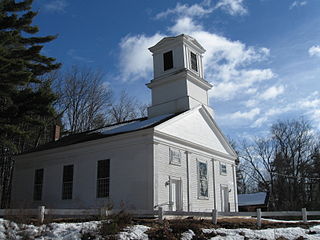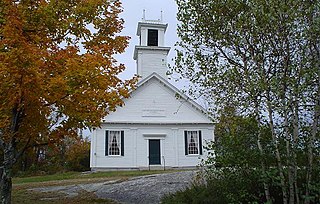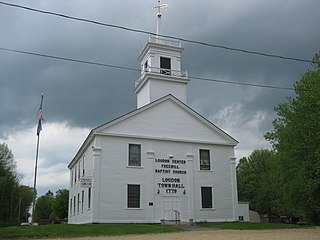
The Chapel of the Holy Cross is a historic church at 45 Chapel Lane on the campus of Holderness School in Holderness, New Hampshire. Built in 1884 to a design by Charles Coolidge Haight, it is a prominent regional example of Gothic Revival architecture. The building was listed on the National Register of Historic Places in 2005.

The First Baptist Church of Gilmanton, also known as the Lower Gilmanton Church, is a historic church building on Province Road, slightly north of Stage Road, in Gilmanton, New Hampshire. Built in 1842, the church is one of Belknap County's finest Greek Revival churches, and is accompanied by the county's most intact 19th-century horsesheds. The property was listed on the National Register of Historic Places in 1989.

The First Free Will Baptist Church in Meredith is a historic church building at 61 Winona Road in Meredith, New Hampshire, United States. Built about 1802 and remodeled in 1848, it is a good example of a mid-19th century vernacular Greek Revival rural church. It is now a museum called the Pottle Meeting House, managed by the local historical society. The building was listed on the National Register of Historic Places in 1986.

The First Freewill Baptist Church is a historic Free Will Baptist church building on Drew Hill Road north of Gilman's Corner Road in East Alton, New Hampshire. Built in 1826, and essentially unaltered since about 1847, it is a well-preserved example of a rural mid-19th century church. The building was listed on the National Register of Historic Places in 1978.

The Cotton Mountain Community Church, also known as the Wolfeborough, Brookfield and Wakefield Meetinghouse, is a historic church on Stoneham Road in Wolfeboro, New Hampshire, near the town line with Brookfield. Built about 1852, it is a well-preserved example of a rural New England meeting house with vernacular Greek Revival style. The building was listed on the National Register of Historic Places in 1985. Since 1957, when it stopped being used for services, it has been cared for by a local nonprofit group.

The First Free Will Baptist Church is a historic church on Granite Road in Ossipee, New Hampshire. The wood-frame white clapboarded building was built in 1856–57, and is a fine little-altered local example of a vernacular Greek Revival country church. The building was listed on the National Register of Historic Places in 1984.

The Union Church is a historic church on South Main Street in South Wolfeboro, New Hampshire, United States. Built in 1845 for the use of several small religious congregations, it is a well-preserved example of mid-19th century vernacular Greek Revival architecture. The building was listed on the National Register of Historic Places in 1982.

The Wolfeboro Centre Community Church is a historic church on New Hampshire Route 109 in Wolfeboro Center, New Hampshire. Built in 1841 for two separate congregations, it is a well-preserved example of a rural mid-19th century church. The building was listed on the National Register of Historic Places in 1984.

Chester Congregational Church is a historic church at 4 Chester Street in Chester, New Hampshire. This wood-frame building was originally built as a traditional New England colonial meeting house in 1773, and underwent significant alteration in 1840, giving it its present Greek Revival appearance. It was listed on the National Register of Historic Places in 1986.

The Free Will Baptist Church is a historic church on Ridge Road in New Durham, New Hampshire. Built in 1819, it is considered the mother church of the Free Will Baptist movement, although it was not built until ten years after the death of founder Benjamin Randall. New Durham is where Randall rose to prominence, and where the church's teachings and governance were organized in 1780. The building was listed on the National Register of Historic Places in 1980.

The East Harpswell Free Will Baptist Church is a historic church on Cundys Harbor Road in East Harpswell, Maine. Built in 1843, it is a little-altered modest Greek Revival structure, with a reversed interior layout that is now extremely rare within the state. It has been used only sporadically since the early 20th century, but is maintained by a local community group. The building was listed on the National Register of Historic Places in 1988.

Jonesboro Union Church is a historic church on Looks Point Road, at the junction with U.S. Route 1 in Jonesboro, Maine. Built in 1841 and significantly restyled in 1911, it is the community's only surviving 19th-century church. It is also notable for its eclectic blend of architectural styles, and is an important early ecclesiastical work of Portland architect Edward Leander Higgins. It was listed on the National Register of Historic Places in 2002.

The First Baptist Church of Bowdoin and Coombs Cemetery are an historic church and cemetery in Bowdoin, Maine. The church, a modest transitional Federal style-Greek Revival building, was built in 1839 for a congregation founded in 1788, and the cemetery is of similar antiquity. The property was the first in the town to be the subject of active preservation efforts. It was listed on the National Register of Historic Places in 1997.

Loudon Town Hall is a historic New England meetinghouse at 433 Clough Hill Road in Loudon, New Hampshire. Built in 1779 and extensively restyled in 1847, this Greek Revival structure was used for many years for both religious and civic purposes; it now serves principally as a church, housing a Free Will Baptist congregation. The building was listed on the National Register of Historic Places in 1990; it is one of the oldest civic buildings in Merrimack County.

The Canaan Street Historic District encompasses the historic original town center of Canaan, New Hampshire. It is a basically linear district, running along Canaan Street roughly from Prospect Hill Road in the north to Moss Flower Lane in the south. The town flourished first as a stagecoach stop, and then as a resort colony in the late 19th century. The historic district was listed on the National Register of Historic Places in 1973. It included 60 contributing buildings.

The Lyme Center Historic District encompasses a modest crossroads and industrial village in rural Lyme, New Hampshire. The predominantly residential district stretches along Dorchester Road, on either side of its junction with Baker Hill Road. The village's rise in development started in the early 19th century as it was at a crossroads of the east-west Dorchester Road, and the north-south Baker Hill Road and Acorn Hill Road. The village grew rapidly in the 1820s, with a number of simple Greek Revival houses, and in 1830 the Baptist Church was built. The other major civic building in the village is the Lyme Academy, built in 1839, albeit with more Federal than Greek Revival styling. Grant Brook, which runs parallel to Dorchester Road, provided a source of power for the growth of small industrial efforts, including a sawmill at the corner of Dorchester and Baker Hill Roads. This industry provided a second minor building boom in the late 19th to early 20th century. Most of the houses in the district are vernacular Greek Revival or Cape in their styling; probably the most elaborate Greek Revival house is the 1857 Beal-Pike House at 41 Dorchester Road.

The Union Meetinghouse or Universalist Church is a historic church building at 97 Amesbury Road in Kensington, New Hampshire. Built in 1839–40, it is a well-preserved and little-altered example of a mid-19th century Greek Revival rural church. It was listed on the National Register of Historic Places in 2013, and continues to be used for summer services.

Unity Town Hall is the town hall of Unity, New Hampshire. It is located in the center of Unity, on the 2nd New Hampshire Turnpike just north of its junction with Center Road. Built in 1831 as a Baptist church, it is a well-preserved example of transitional Federal-Greek Revival styling. The building was listed on the National Register of Historic Places in 1985.

The Putney Village Historic District encompasses most of the main village and town center of Putney, Vermont. Settled in the 1760s, the village saw its major growth in the late 18th and early 19th century, and includes a cohesive collection with Federal and Greek Revival buildings, with a more modest number of important later additions, including the Italianate town hall. The district was listed on the National Register of Historic Places in 1986.

Hastings Unitarian Church, also known as Hastings Unitarian and Free Christian Church, is a place of worship for Unitarians in the town and borough of Hastings, one of six local government districts in the English county of East Sussex. It has been in continuous use since it was built in 1868, having been founded the previous year by prominent Unitarian John Bowring for a congregation which had met in hired premises since 1858. The church, designed by George Beck, is Neoclassical in style and has an 18th-century organ.























